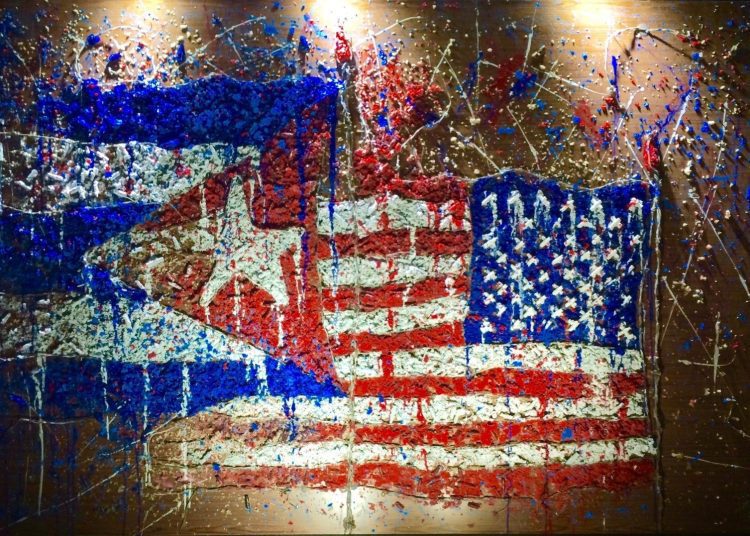When I teach the history of the Revolution, the problem to be solved is not the “banned books” by emigrated authors; say, Jorge Domínguez, Emilio Cueto, Uva de Aragón, Carmelo Mesa-Lago, Ada Ferrer, Alejandro de la Fuente, Jorge Duany, Lisandro Pérez, Guillermo Grenier, Alan West-Duran, Iraida López, Ruth Behar, Miren Uriarte, Alejandro Portes, Roberto González Echeverría, to mention only a few who are alive, among many. Although the majority do not share the ideology of Cuban socialism, they are known, cited, commented, used in classes, and almost all of them published here.
The great current paradox, however, is that accessing documents, recordings, key speeches of our leaders, especially the so-called historical ones, is much more difficult than those of these emigrated authors.
Last week, during a three-part debate on counterpoints in the field of art and literature, under the umbrella of Temas and the Union of Writers and Artists of Cuba (UNEAC), the filmmaker Manuel Pérez recalled Fidel’s speech at the 1971 Congress of Education and Culture, in which he had defended the Cuban Institute of Art and Cinema Industry (ICAIC) policy against those who tried to drag it into the canons of socialist realism. Manolo, with his memory of fly paper (Roa dixit) and his lucid passion intact at the age of 84, evoked precisely the words of that foreign minister with whom he shared the table in a Commission of the aforementioned Congress when he had whispered to him: “You can already leave calmly, ICAIC has been saved.”
How many articles, essays, books that address the cultural policies and political cultures of the 1960s and 1970s, including the infamous Gray Quinquennium, have been written without knowing the intra-history of events such as the Padilla case, the cultural congresses of 1968 and 1971, the ins and outs of the Critical Thinking affair, the struggles that led to the founding of the Ministry of Culture, the recovery of many works of writers and artists who left. How much literature that continues to play by ear (and only one ear) passes by the wealth of live events, data, documents, letters, reports, photos, old notebooks, which carries on its back — that is to say — that living fountain that we affectionately call Manolo Pérez.
A film scriptwriter would say that it is a factory of plots and subplots, where contingencies are linked to characters and events of the process — political, social, ideological — and its contradictions, some formidable; more similar to a Balzac novel than to the quota of patron saints and anniversaries that students and spectators face every day. Or the cloud of gases that spread on the networks, disguised as alternative truths. Well, among the issues that should be dusted off from so much occultism and ideological dust is that of dialogue with the emigrants.
It is enough to access the archived documents, a minimal part declassified, to glimpse the many shores of this plot. Which continues to be evoked only as a kind of television series whose chapters throughout forty-five years are limited to the same characters, to those same photos, in one of those linear chronologies that try to demonstrate the perfect continuity of politics, instead of a critical story.
Basing myself on what has been brought to light, I want to argue why the meeting called The Nation and Emigration, which is just around the corner in three weeks, should not be understood as another season in that TV series.
The first thing is that, as an area of Cuban politics, this is one of those (few) topics of which it can be said that “nevertheless, it moves.” In this case, the crests of the iceberg are visible to anyone who wants to see them.
New regulations that make passport renewal more flexible, customs changes to facilitate shipments and imports of medicines and food, meetings of some entrepreneurs with authorities on the island, and most especially, talks at the level of the president and emigrated businesspeople about the — much talked about — real space to invest in Cuba. The unusual event, in Miami, with the participation of numerous private entrepreneurs from here and others from there, is the latest notable event.
None of this happens as a result of concurrent chance or the fluctuations of the situation, but rather of the larger political context in which it takes place, including the relations between the two governments. I want to start by discussing how connecting with previous moments helps us understand and compare it.
What would later be called the dialogue with the Cuban community abroad was an initiative from here and, like almost everything important, it did not appear in the newspapers (“it had to be in silence,” Martí said). It was an action of double metadiplomacy: it did not involve diplomats, but rather intelligence agents; and the main interlocutors on the other side were not proxies for government agencies (like the famous lawyer James Donovan), but real leaders of the Cuban-American business elite.
By the time Bernardo Benes and Fidel Castro sat down to agree on the smallest aspects of the dialogue agenda, the banker had long had the green light from the CIA, and President Carter knew what was happening.
According to Bill Leogrande and Peter Kornbluh’s extensive documents and sources in their magnum opus Back Channel to Cuba, once the U.S. government agencies — especially the National Security Council (NSC) and the State Department — read the Cuban signals to advance in the official dialogue with the Carter administration, they started going around Benes and the other emigration leaders. That was the end of the role of brokers that they proposed to play. Of course, they were not going to sit at the negotiating table, because it was not their turn.
For their part, Cuban negotiators realized that the banker’s good intentions went beyond the real scope of U.S. policy towards Cuba, whose goal then was not so much to promote “human rights” as to get Cuba out of Africa.
However, on this side, the meta-diplomatic channel with which Cuba from the outside remained open, and directed towards new results.
That negotiation between Fidel and members of the Cuban-American business elite that began in August 1977 would stage, fifteen months later, the meeting of the 75 representatives of a very diverse emigration with the Cuban government top brass in Havana.
In that interim, there would be two public meetings. One (January 1978) with the daring left of young emigrated intellectuals, who had dared to found a magazine and defend the Revolution in the most adverse circumstances possible, literally risking their lives. The other, with emigrated journalists (September 1978), on the eve of the public meeting. In that same period, more than a dozen secret meetings occurred, which set the pace of the event’s agenda.
The main topics that, from the beginning of the dialogue, the emigration leaders brought up were summarized in three: family reunification, return (that is, visits to the island) and release of political prisoners.
On the Cuban side, Fidel was favorably disposed toward all three, starting with the one that seemed most difficult: that of the prisoners. There were 3,600 who were serving long sentences, none of which were for protesting, speaking or writing against the Revolution, but for violent actions that dated back to the height of armed subversion and civil war.
This initial disposition, aimed at promoting a new relationship with the United States, led to the opening of stable diplomatic channels between the two governments to discuss the greater agenda.
Cuba’s signals responded to a political logic that was not negotiating for the sake of negotiating. They were based on a comprehensive and binding negotiation process, which instead of separate topics, included the most burning of its foreign relations, such as Africa; but as long as the United States walked equally in relation to the blockade, shut down terrorism, renounced prior conditioning and double standards. That negotiating strategy was not like a five-year plan of guidelines, but rather like a game of chess, subject to how the game progressed.
To appreciate the logic of that Cuban moment, you have to understand the national and international context. Inside, the country had emerged from the crisis, the promise of well-being with equality had been consolidated, and a political system institutionalized and ordered by a new constitution was taking off. Externally, although its alliance with the USSR had been strengthened, Cuban foreign policy was not that of a Moscow satellite, neither in Africa, nor in Latin America, nor in the context of the Non-Aligned countries, in which its leadership was recognized. For Cuban politics, let’s say, it was a moment of consensus and strength.
That said, the situation of relations with emigrants was not so easy to process internally. Although the motto of the First Congress of the Communist Party, in 1975, was “Men die, the Party is immortal,” the political power of the government and the Party, institutions with a role very similar to that of today, was not comparable to that of that leadership. So when the Communist Party of Cuba (PCC) and the government made Fidel aware of the effect of confusion that the unexpected political mess with the community and the Americans was causing in the people, he would have to resort to his moral authority and political reason to handle the situation. He could do it, and he knew how. Up to a certain point.
Fresh in everyone’s memory were the terrorist attack on the coastal town of Boca de Samá (1971), the murder of Cuban fishermen (1973), the strange epidemics of swine fever (1971), tobacco blue mold (1978), sugarcane rust (1978, the impunity with which terrorist organizations such as Omega 7 and Alpha 66, whose headquarters were based in Miami, operated. Just two years earlier, a Cuban plane with more than 70 civilians on board had been sabotaged by a terrorist commando belonging to an organization of that barbaric exile, which had planned and executed it. Fidel himself, when he gave the speech for the mourning of the dead in Barbados, had pointed to their headquarters in Miami as those directly responsible for the action, and blamed the national security agencies of the United States for letting them do it, denouncing, in protest, the treaty on airplane hijackings signed shortly before between both governments (1973).
So when he decided to meet with several thousand PCC members at the Karl Marx Theater to explain his new policy towards emigrants, in 1978, he had to work hard for six hours.
In this column, I have glossed over what is known about that speech, whose fragments of a very long intervention were published just three years ago as part of a book printed outside of Cuba. Since almost no one even knows these published pieces, I return to them.
These explanations to the Party members occurred almost three months after the first meeting of the dialogue with the emigrants in November 1978. As far as we know, in them, Fidel pronounced several concepts that today we could consider strategic. To paraphrase, this is what he said in February 1979.
The link of the majority of that community with Cuba has a national (non-ideological) component, which by its very nature is related to the idea of change, and progress, that is, it is closer to the Revolution than to the conservative ingredient of the counterrevolution. Even among those who do not share the socialist ideal, Cuban political culture is more similar to what the Revolution has rescued as a national legacy. So, due to this historical gravitation, this emigration is called to defend the national interest, over any other.
We have become accustomed to a combat policy, because it has been imposed on us, but also because “it arouses emotions” related to heroism, especially “among ardent and passionate temperaments.” So a policy of peace is much more difficult to build and prevail. Coexisting with capitalism, and negotiating with it, costs us much more work.
The historical strategy of the Cuban Revolution has been, since before the triumph, to win over the adversaries. To not morally despise the enemy, nor judge him to be a coward. So “many Batista soldiers are today members of our Party,” “vanguard workers, distinguished workers.” The Revolution consists of a process of transformation of human beings, based on their virtues and moral capacities, from which “they can become a revolutionary.”
The strategic lesson about unity is that it applies to adversaries, not to those who think like us. It is about attracting them so that “in one way or another, they serve the Revolution.”
Finally, the great lesson that is derived from this unitary strategy is that ideological purity is not revolutionary, because in a state of asepsis, in a vacuum chamber, where there is “not the slightest temptation, nor the slightest contact,” nothing is proven. “A revolutionary cannot fear ideological contact, confrontation.” Believing that this implies “getting muddy” is a mistake. On the contrary: only contact and coexistence can make revolutionary virtues shine, be tested, and aspire to a certain purity that is legitimate.
I suppose it is obvious at this point in the game that the next chapter of this dialogue occurs at a historical moment that Fidel Castro himself would have described as very different. However, we can learn something from this review of the past.
What do the forty-five years that have passed since the first dialogue teach us? To what extent do current circumstances, here and abroad, favor a political dialogue that converges in the national interest? How to define this interest, according to strategic objectives, that is not restricted by ideological differences? Where does a democratic, patriotic, pluralistic representation of the national condition end, different from the banal relativism of “we are all Cubans”? What foundations can we lay for a social and political pact of Cubans from here and there that does not remain in goodwill, codes, short-term economic motives, signed papers? What spaces are there here for those who are outside, and how to combine them with those of those who are here? How can we imagine defending the national interest among all? How can we ensure that this nation project inside and outside does not remain in meetings, but rather is articulated in the social and political order of this nation? So that it is not exposed to the ups and downs of relations with the United States?
Reconciliation between families, and the agreement of our disagreements, as well as dialogues in the fields of culture, academia, science, and faith, contain lessons that we should share, so as not to trip over the same stones again.










